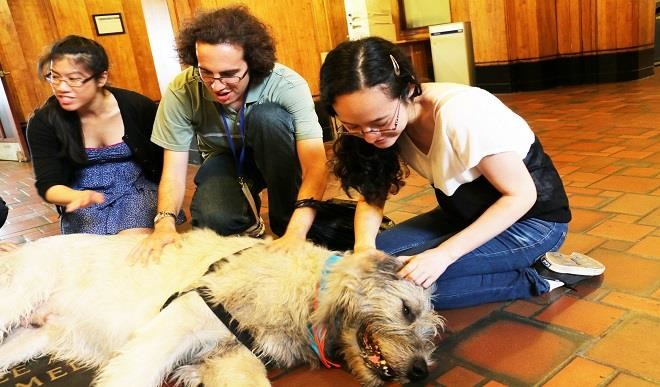
It did not take long for me to recognize the therapeutic potential of Max, the hypoallergenic five-month-old Havanese puppy I adopted in March 2014. He neither barked nor growled and seemed to like everyone, especially the many children that come up and down our block.
When I asked if a crying child passing by would like to pet a puppy, the tears nearly always stopped as fluffy little Max approached, ready to be caressed.
So I signed us up for therapy dog training with the Good Dog Foundation, which met conveniently in my neighbourhood. If we passed the six-week course, we would be certified to visit patients in hospitals and nursing homes, children in schools, and people in other venues that recognize the therapeutic potential of well-behaved animals.
Training involves a joint effort of dog and owner, usually in groups of four to eight pairs. The dog can be any size, any breed, but must be housebroken; non-aggressive; not fearful of strangers, loud or strange noises, wheelchairs or elevators, and able to learn basic commands like sit, lie down and leave it. Good temperament is critical; a dog that barks incessantly, nips or jumps on people uninvited would hardly be therapeutic.
During our first visit to patients at my local hospital, a woman who said she’d had a “terrible morning” invited Max onto her bed, showered him with affection and, crying with pleasure, thanked me profusely for bringing him around to cheer her up.
Moments later, on the paediatric ward, a preverbal toddler hospitalized with croup spotted Max and came charging down the hall squealing with delight. The two met eye-to-eye; Max even appeared to smile, and she giggled as she patted his head.
I don’t know about Max, but I was hooked. I agreed to bring him for monthly patient visits, with a promise to do more if my schedule permitted, and I was able to do the required pre-visit bath.
A therapy dog need not be small and fluffy. A neighbour with a “mush” of a 90-pound American pit bull named Pootie has had similar experiences at the Veterans Affairs New York Harbor Healthcare System’s Brooklyn campus. During the first visit, one patient told him repeatedly, “You made my day.”
But while a hospital’s voluntary pet therapy program is designed to aid patients, in my experience the chronically-stressed hospital staff benefits as much if not more from pet visits. “Can I pick him up?” is the typical request from hospital personnel I encounter, and some don’t even wait for me to say yes.
Therapy pets differ from service animals like those that guide the blind, detect impending health crises for people with epilepsy or diabetes, or stimulate learning for children with autism or cerebral palsy.
Pet therapy most often involves privately owned animals – usually dogs, but also cats, rabbits, even kangaroos, birds, fish and reptiles – that their owners take to facilities to enhance the well-being of temporary or permanent residents. Thus, in addition to relieving the monotony of a hospital stay or entertaining residents in a nursing home, Max might visit a school where young children wary of reading aloud will happily read to a dog that does not care about mistakes.
At my local hospital, therapy dogs often attend group sessions for psychiatry patients. Cynthia Chandler, a counselling professor at the University of North Texas and author of “Animal Assisted Therapy in Counselling,” reports that visits by her dog Bailey increased patient participation in group therapy and improved hygiene and self-care among those with severe mental illness.
At Veterans Affairs hospitals, not only therapy dogs but also parrots have reduced anxiety and other symptoms among patients being treated for post-traumatic stress disorder.
Valerie Abel, a psychologist who coordinates the pet therapy program at the Brooklyn Veterans Affairs hospital, said, “The presence of therapy dogs makes such a difference. Many ask when they’ll next be back. A big dog can put its head on patients’ beds and you can actually see them relax.”
Studies have shown that after just 20 minutes with a therapy dog, patients’ levels of stress hormones drop and levels of pain-reducing endorphins rise. Endorphins are the brain’s natural narcotic, the substance responsible for the runner’s high that helps injured athletes ignore pain.
In elderly patients with dementia, depression declines after they interact with a therapy animal. And researchers at the University of Southern Maine showed that therapy dog visits can calm agitation in patients with severe dementia.
In a controlled study of therapy dog visits among patients with heart disease, researchers at the University of California, Los Angeles, found a significant reduction in anxiety levels and blood pressure in the heart and lungs in those who spent 12 minutes with a visiting animal, but no such effect occurred among comparable patients not visited by a dog.
Therapy dogs are often described as better than any medicine. They know instinctively when someone needs loving attention. Last winter, when I was felled by the flu (despite my annual shot), 1-year-old Max lay at the foot of my bed for hours on end, making none of his usual demands for attention and play.
In an intriguing pet therapy program, sometimes called pets behind bars, benefits accrue to both the animals and the humans with whom they interact. Shelter dogs considered unadoptable and living on “death row” are assigned to be cared for and trained by selected prison inmates, including convicted killers and rapists, many of whom have serious anger issues.
The inmates work to socialize the dogs, teaching them to trust people, behave appropriately and obey simple commands. In turn, violence and depression among the inmates is lessened; they learn compassionate behaviour, gain a sense of purpose and experience unconditional love from the dogs in their care.
At the completion of training, rehabilitated dogs are offered to people who want to give a shelter animal a permanent home. Through the Safe Harbor Prison Dog Program at Lansing Correctional Facility in Lansing, Kansas, for example, some 1,200 dogs have been adopted as pets.
In a related program, veterans back from service in Iraq and Afghanistan are giving basic obedience training to shelter dogs, a project that helps the vets readjust to being home and offers the dogs a chance to gain a home of their own.
Before signing up for therapy dog training, you’d be wise to find out first what the program involves and its cost and what will be required of you by the facilities you hope to visit. I’ve had to provide annual documentation of Max’s vaccinations and freedom from intestinal parasites, which typically requires a visit to the vet. I too had to show I was immune to multiple infectious diseases and free of HIV, and the hospital had to test me for drug abuse.
Still, the rewards Max and I have accrued as hospital volunteers more than compensate for these requirements.
Distributed by The New York Times

 Join Daily Trust WhatsApp Community For Quick Access To News and Happenings Around You.
Join Daily Trust WhatsApp Community For Quick Access To News and Happenings Around You.


